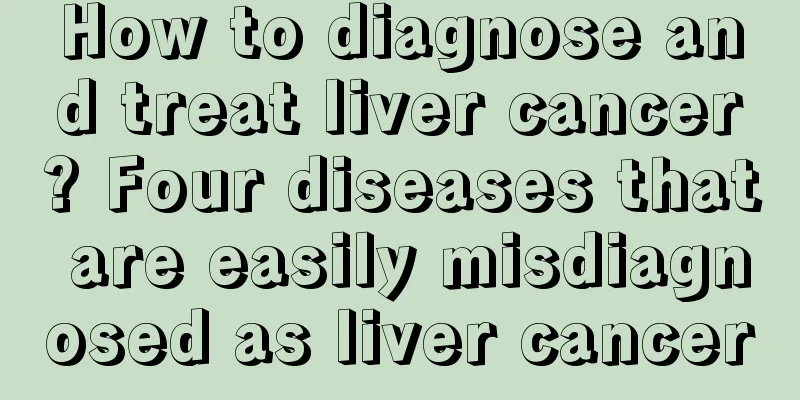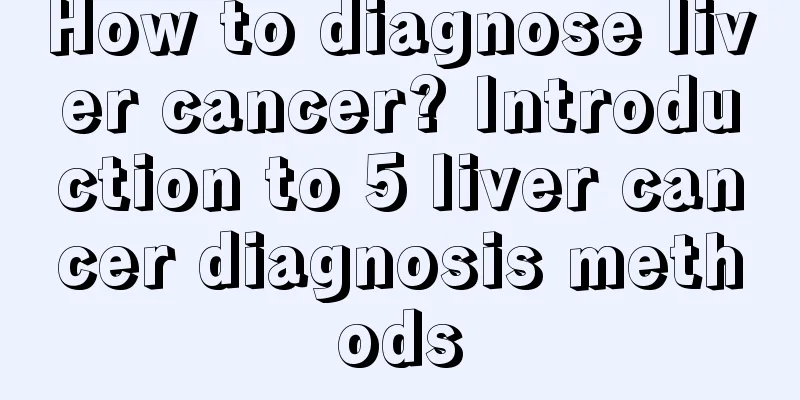How to diagnose and treat liver cancer? Four diseases that are easily misdiagnosed as liver cancer

|
The increase in hepatitis B patients in recent years has also led to an increase in liver cancer patients. Currently, according to statistics, liver cancer is the second most common cancer in China, second only to lung cancer in prevalence. The early symptoms of liver cancer are not very obvious, but this period is often the golden period for treating liver cancer. So how can liver cancer be diagnosed as quickly as possible? Four diseases that are easily misdiagnosed as liver cancer Granuloma: Some female patients may have isolated, smooth, and complete nodules in the liver due to oral contraceptives, parasitic infections, or autoimmune disorders, which are difficult to distinguish from liver cancer on imaging. It is recommended to perform histological examination under ultrasound or CT guidance. Cirrhotic nodules: Cirrhosis nodules are most likely to be diagnosed as liver cancer, because most primary liver cancers will develop into cirrhosis, and patients with severe cirrhosis will have a large number of hyperplastic nodules, which are difficult to distinguish from early liver cancer. It is recommended to perform an ultrasound or CT-guided puncture biopsy for accurate diagnosis. Liver abscess: Patients have clinical manifestations such as fatigue, low fever, weight loss, and discomfort in the liver area. It is difficult to distinguish them from liver cancer in the early stage of the disease, and a comprehensive judgment is needed based on biochemical indicators such as blood routine, AFp, and liver function. Hepatic hemangioma: Hepatic hemangioma and hepatocellular carcinoma are easily confused. In fact, hemangioma grows slowly and generally has no history of chronic liver disease. There are no clinical manifestations such as fatigue, poor appetite, abdominal distension, etc., and there will be no physical signs such as liver palms, spider nevi, jaundice, and edema of both lower limbs. Uneven fatty liver: Some patients with fatty liver have uneven fat accumulation, which is sometimes difficult to distinguish from liver cancer. Clinically, fatty liver does not have the systemic manifestations of liver cancer patients, such as abdominal distension, diarrhea, discomfort in the right liver area, and weight loss. How is liver cancer diagnosed? B-ultrasound can only detect suspicious nodules. CT or MRI is needed to confirm the diagnosis. If enhanced CT has the characteristic of "fast in and fast out" of contrast agent, it can generally confirm the diagnosis. Alpha-fetoprotein is a marker for diagnosing liver cancer, but an increase in its level does not necessarily mean liver cancer; nor does an increase in its level necessarily mean liver cancer. Liver cancer diagnosis generally does not require puncture, as cancerous nodules smaller than 3 cm are difficult to puncture and may cause tumor spread along the path of the puncture needle. Five treatment methods for liver cancer Individualized comprehensive treatment according to different stages of liver cancer is the key to improving the efficacy; treatment methods include surgery, hepatic artery ligation, hepatic artery chemoembolization, radiofrequency, cryosurgery, laser, microwave, chemotherapy and radiotherapy. Biological treatment and traditional Chinese medicine are also widely used in the treatment of liver cancer. 1. Surgical treatment Surgery is the first choice and the most effective method for treating liver cancer. Surgical methods include radical liver resection, palliative liver resection, etc. 2. Treatment of unresectable liver cancer For liver cancer that cannot be removed, treatments such as intraoperative hepatic artery ligation, hepatic artery chemoembolization, radiofrequency, cryosurgery, laser, and microwave can be used according to specific circumstances and have certain effects. Primary liver cancer is also one of the indications for liver transplantation. 3. Chemotherapy If the laparotomy reveals that the tumor cannot be removed, or as a follow-up treatment for palliative tumor resection, regional chemoembolization can be performed by placing a pump (subcutaneous buried perfusion device) in the hepatic artery and/or portal vein. For those who are estimated to be unresectable by surgery, radiological intervention can also be performed, with selective cannulation through the femoral artery to the hepatic artery, and injection of embolic agents (commonly used such as iodized oil) and anticancer drugs for chemoembolization. Some patients may therefore have the opportunity for surgical resection. 4. Radiation therapy For patients with good general condition, good liver function, no cirrhosis, no jaundice, ascites, hypersplenism and esophageal varices, relatively localized tumor, no distant metastasis, but not suitable for surgical resection or recurrence after surgery, comprehensive treatment with radiation as the main method can be used. 5. Biological therapy Commonly used ones include immune RNA, interferon, interleukin-2, thymosin, etc., which can be used in combination with chemotherapy. 6. Treatment with traditional Chinese medicine The method of syndrome differentiation and treatment, combined with attack and supplement, is often used in conjunction with other therapies to enhance the body's resistance to disease, improve overall condition and symptoms, and reduce adverse reactions to chemotherapy and radiotherapy. |
<<: Where is liver cancer most likely to metastasize? How to prevent metastatic liver cancer?
>>: How can soy sauce cause liver cancer? Revealing four unfavorable diets that affect liver cancer
Recommend
Can lymphoma be cured
Lymphoma brings a lot of fear to patients. In the...
What will be the consequences if forehead inflammation is not treated?
Frontal sinusitis is a very common disease, and i...
What should I pay attention to when I have pimples on my back
Acne is a headache for young people during adoles...
The efficacy and function of mango mask
Mango is a common fruit in our lives. It tastes s...
Is it good to have lip tattoos? It turns out the effect is like this
Some people in life are born with ugly lips, and ...
How many types of onychomycosis are there
Onychomycosis is a relatively common nail disease...
Patients with laryngeal cancer should pay more attention to its common symptoms
In recent years, the incidence of laryngeal cance...
3 tips to help brain cancer patients protect their eyesight
Brain cancer patients often experience visual imp...
What should I do if I can’t urinate after holding my urine?
Holding urine is something that everyone has expe...
Can nasopharyngeal cancer be cured by surgery? Which mechanism is better?
Nasopharyngeal carcinoma is one of the most annoy...
Tips for peeling walnuts
Walnut is a type of dried fruit. The skin of the ...
Is the cure rate for tongue cancer high?
In today's life, there are more and more type...
How to make a pathological diagnosis of skin cancer
The environment we live in today has many polluta...
What can I eat on the fourth day of appendicitis
Clinically, the problem of appendicitis is quite ...
Analyzing the causes of colorectal cancer
In recent years, colorectal cancer has become one...









